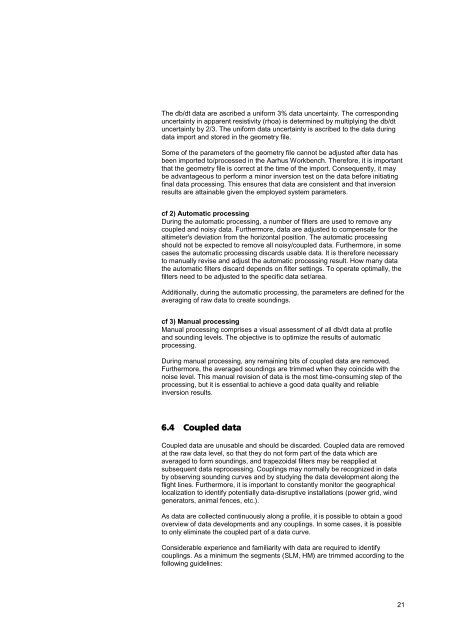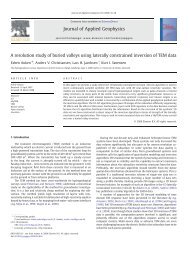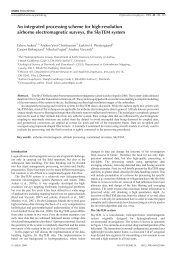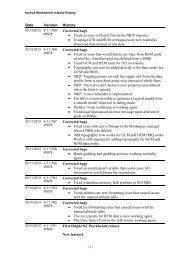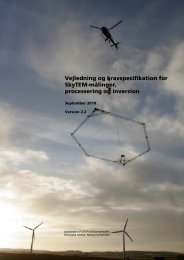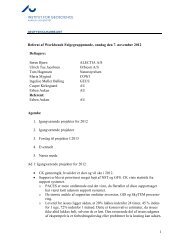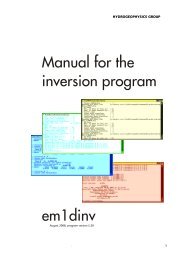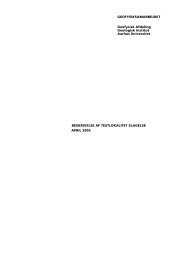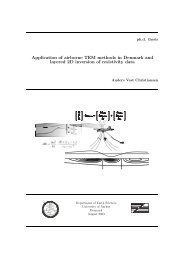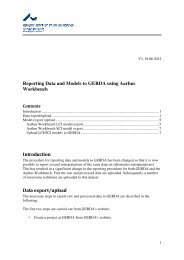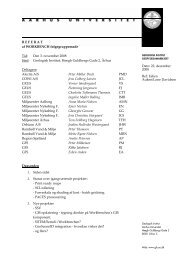guideline and standards for skytem measurements, processing and ...
guideline and standards for skytem measurements, processing and ...
guideline and standards for skytem measurements, processing and ...
Create successful ePaper yourself
Turn your PDF publications into a flip-book with our unique Google optimized e-Paper software.
The db/dt data are ascribed a uni<strong>for</strong>m 3% data uncertainty. The corresponding<br />
uncertainty in apparent resistivity (rhoa) is determined by multiplying the db/dt<br />
uncertainty by 2/3. The uni<strong>for</strong>m data uncertainty is ascribed to the data during<br />
data import <strong>and</strong> stored in the geometry file.<br />
Some of the parameters of the geometry file cannot be adjusted after data has<br />
been imported to/processed in the Aarhus Workbench. There<strong>for</strong>e, it is important<br />
that the geometry file is correct at the time of the import. Consequently, it may<br />
be advantageous to per<strong>for</strong>m a minor inversion test on the data be<strong>for</strong>e initiating<br />
final data <strong>processing</strong>. This ensures that data are consistent <strong>and</strong> that inversion<br />
results are attainable given the employed system parameters.<br />
cf 2) Automatic <strong>processing</strong><br />
During the automatic <strong>processing</strong>, a number of filters are used to remove any<br />
coupled <strong>and</strong> noisy data. Furthermore, data are adjusted to compensate <strong>for</strong> the<br />
altimeter's deviation from the horizontal position. The automatic <strong>processing</strong><br />
should not be expected to remove all noisy/coupled data. Furthermore, in some<br />
cases the automatic <strong>processing</strong> discards usable data. It is there<strong>for</strong>e necessary<br />
to manually revise <strong>and</strong> adjust the automatic <strong>processing</strong> result. How many data<br />
the automatic filters discard depends on filter settings. To operate optimally, the<br />
filters need to be adjusted to the specific data set/area.<br />
Additionally, during the automatic <strong>processing</strong>, the parameters are defined <strong>for</strong> the<br />
averaging of raw data to create soundings.<br />
cf 3) Manual <strong>processing</strong><br />
Manual <strong>processing</strong> comprises a visual assessment of all db/dt data at profile<br />
<strong>and</strong> sounding levels. The objective is to optimize the results of automatic<br />
<strong>processing</strong>.<br />
During manual <strong>processing</strong>, any remaining bits of coupled data are removed.<br />
Furthermore, the averaged soundings are trimmed when they coincide with the<br />
noise level. This manual revision of data is the most time-consuming step of the<br />
<strong>processing</strong>, but it is essential to achieve a good data quality <strong>and</strong> reliable<br />
inversion results.<br />
6.4 Coupled data<br />
Coupled data are unusable <strong>and</strong> should be discarded. Coupled data are removed<br />
at the raw data level, so that they do not <strong>for</strong>m part of the data which are<br />
averaged to <strong>for</strong>m soundings, <strong>and</strong> trapezoidal filters may be reapplied at<br />
subsequent data re<strong>processing</strong>. Couplings may normally be recognized in data<br />
by observing sounding curves <strong>and</strong> by studying the data development along the<br />
flight lines. Furthermore, it is important to constantly monitor the geographical<br />
localization to identify potentially data-disruptive installations (power grid, wind<br />
generators, animal fences, etc.).<br />
As data are collected continuously along a profile, it is possible to obtain a good<br />
overview of data developments <strong>and</strong> any couplings. In some cases, it is possible<br />
to only eliminate the coupled part of a data curve.<br />
Considerable experience <strong>and</strong> familiarity with data are required to identify<br />
couplings. As a minimum the segments (SLM, HM) are trimmed according to the<br />
following <strong>guideline</strong>s:<br />
21


